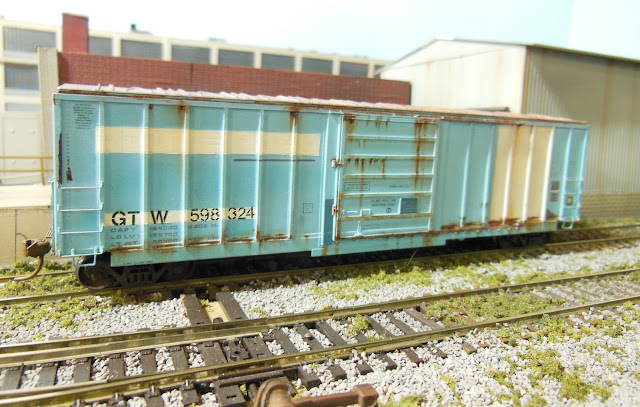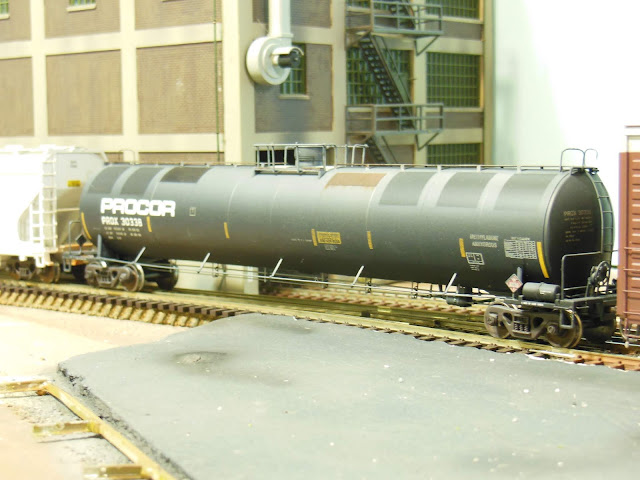I also had this other Exactrail Evans boxcar in my cupboard that I didn't at all like the way it had turned out. Here's what it looked like, below. No one wanted to buy this at the Woodstock train show last year either, and really, I don't blame them. I mean, the rust streaks were alright, but the blue patching was "overpowering" at best, and I hadn't faded the original blue down properly. (I like to think I'm getting better at that now).
I figured that as long as I was going to re-do one car, I might as well re-do two. So, out came the 99% alcohol and Q-Tips, and over the course of the next hour or two, off came the weathering and the patching.
With that done, I faded the original Rock Island blue with ModelFlex Concrete Gray. That's such a great colour for fading paint. I masking-taped off the areas I wanted, and sprayed a light gray where the patches were to go. Reporting marks and numbers decals were re-done as well, and then the rust weathering added.
With that done, I faded the original Rock Island blue with ModelFlex Concrete Gray. That's such a great colour for fading paint. I masking-taped off the areas I wanted, and sprayed a light gray where the patches were to go. Reporting marks and numbers decals were re-done as well, and then the rust weathering added.
So now 598324 (seen above with the white patches) has become former GTW 598211, and looks like this...
The notice on the tack-board is a tiny piece of an orange price tag sticker. I faded the colour of it with some thinned grey paint and stuck it on there. If it falls off, well that's prototypical, and it'll just add to the litter that's scattered around the railway.
And a view of the other side...
The notice on the tack-board is a tiny piece of an orange price tag sticker. I faded the colour of it with some thinned grey paint and stuck it on there. If it falls off, well that's prototypical, and it'll just add to the litter that's scattered around the railway.
And a view of the other side...
The pieces of old tape seals at the door are small bits of white decal. The door on this side received less of the fading, and is closer to the original colour of the model
And as for the boxcar that had the overpowering blue patches, it went through the same basic process as above, just masked and patched differently.
Here's a look at the prototype photo that inspired the patching for this 2nd car. This photo by Randy Curlin, found on rrpicturearchives.net
I kept the colour difference from the new patching and the faded blue is much more subtle on this one. Here's a look...
And the other side...
And here are the two GTW patched boxcars together...
I like both of these boxcars much more now than before, so they'll probably see more time on the layout.
Here's a look at the prototype photo that inspired the patching for this 2nd car. This photo by Randy Curlin, found on rrpicturearchives.net
I kept the colour difference from the new patching and the faded blue is much more subtle on this one. Here's a look...
I've painted one door with the same grey paint that I used for the patching.
And the other side...
And here are the two GTW patched boxcars together...
I like both of these boxcars much more now than before, so they'll probably see more time on the layout.
Stay safe out there everyone, and stay home.
Jim
























